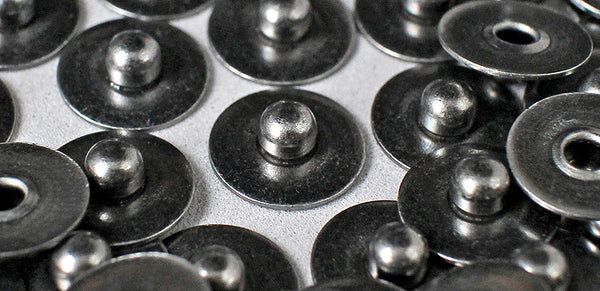Nipple Rivets for Jeanswear

Nipple Rivet is the first rivet in the world. It first appeared in Levi’s Jeans placed at a stress point to prevent tearing. Since that, lots of famous brands followed, such as Ben Davis, Lee, and Wrangler from America; Reply, Diesel, Pepe Jeans, G-Star from Europe; Denime, and Edwin from Asia. Nipple rivets were suddenly booming and causing a sensation in the world. They are not only commonly used as a method of pocket reinforcement for jeans, corduroy trousers, and twill pants but also as an ornamentation. Nipple rivet is actually an ever-popular element on jeans and has become a fashion trend until now. As one of the essential elements of the original jeans, nipple rivets can give you the strongest impression of classic jeanswear.
The tiny discreet round metals on the jean’s corner pocket may look randomly attached but they’re not buttons, these are called rivets. And its function is not to snap, but to bolster an area in the jeans primarily those that can easily wear and tear. Jeans rivets are commonly used as a method of pocket reinforcement for jeans or heavy trousers, and also as a means of decoration on a garment. Tracing back to the late 19th century, gold diggers started to complain their Jeans were not strong enough for the front pockets. The heavy and rough mineral samples that they put into the pockets quite often, destroyed the thread of the trouser pockets. In this case, the gold diggers couldn’t hold more gold in their pockets. Realizing this circumstance, a tailor from Nevada called Jacob W. Davis had a concept of how to reinforce jeans pockets with copper rivets. He approached Levi Strauss and worked with Levi’s company, ”Improvements in fastening pocket openings” which rapidly spread in the world and applied to jeans. The first rivet – jeans nipple rivet placed at stress points to prevent tearing. This is how the first rivet came out and became one of the important elements in jeans.
WHY NIPPLE?
Technically, it is likely to make a variety of designs of rivet as long as it secures seams and pockets. Although it may be similar to screws which have two parts, rivets don’t have the threads (spirally teeth). Jean rivet consists mainly of 2 components, the rivet which is attached to the top or outer layer of fabric while the other side which serves as the base is the tack. Now the question is, why do the nipple rivets look like nipples? Basically, this is the original design patented by JD and Levis. When a rivet is pressed, the tack gets squished into the hollow part (nipple) then it deforms to lock the two parts together. Considering the length of the tack is also important to avoid loose rivets. In some cases, a plastic washer is placed in between if the tack overdoes the necessary length.
